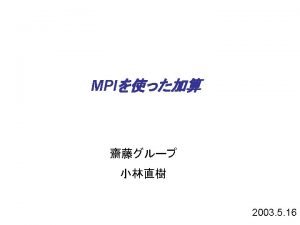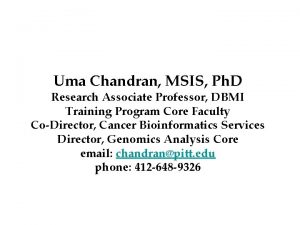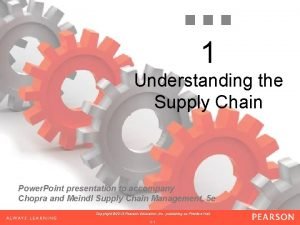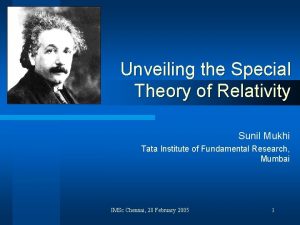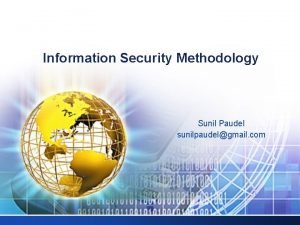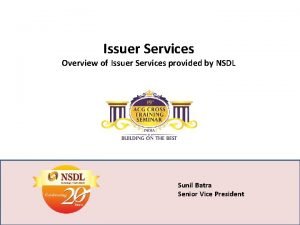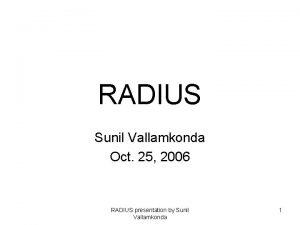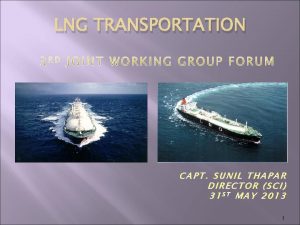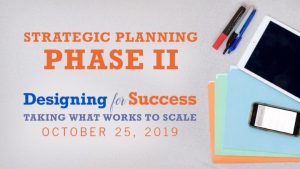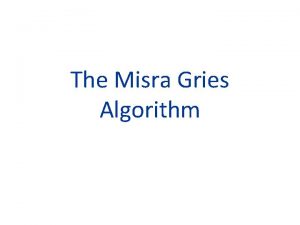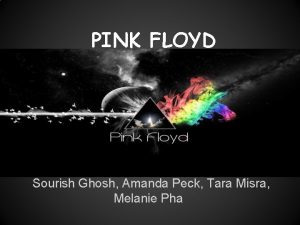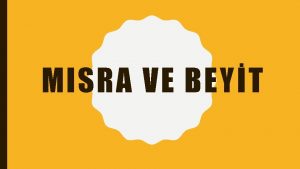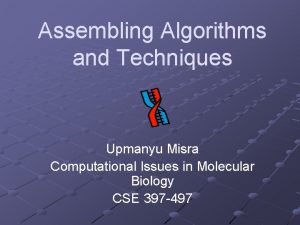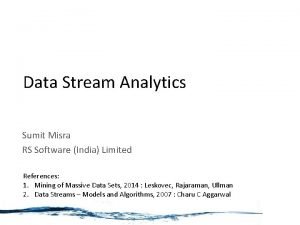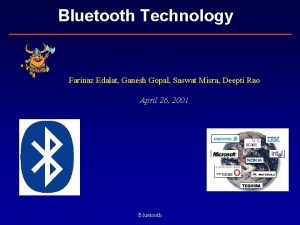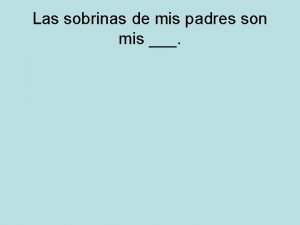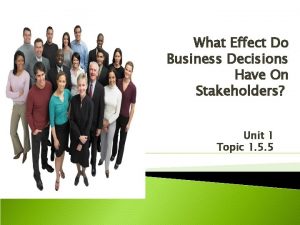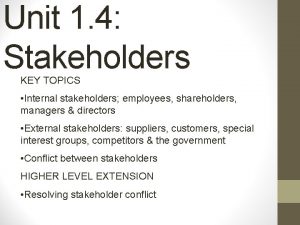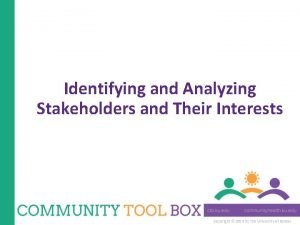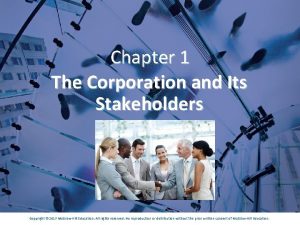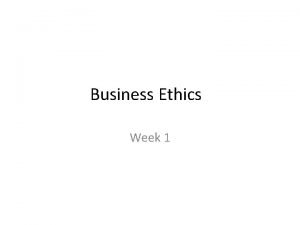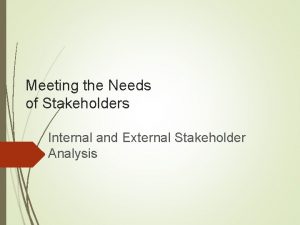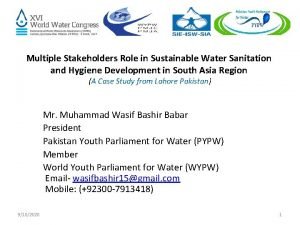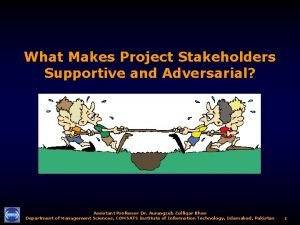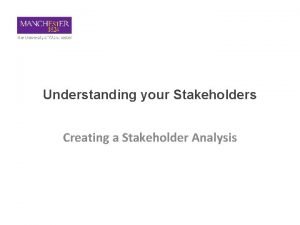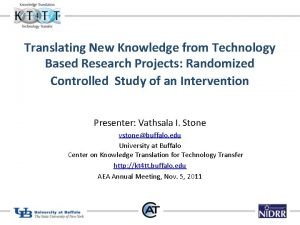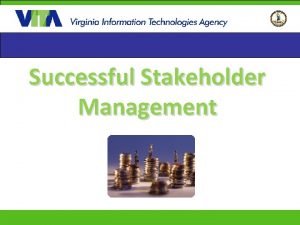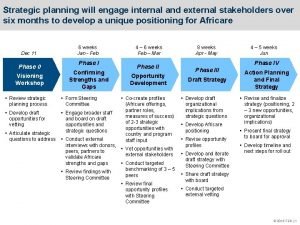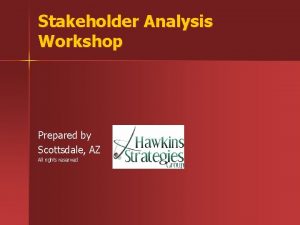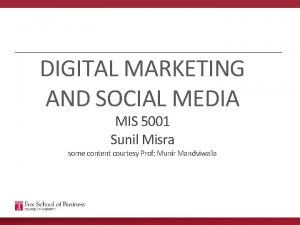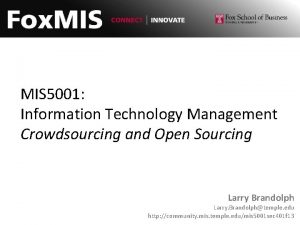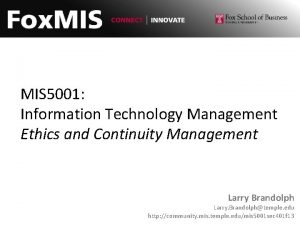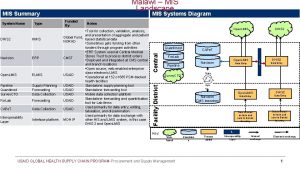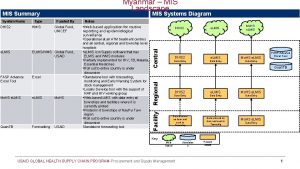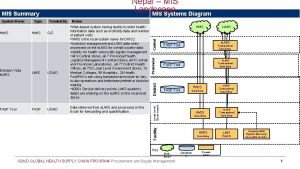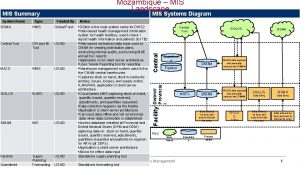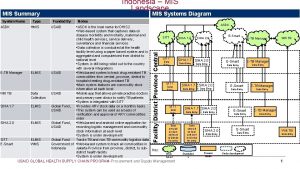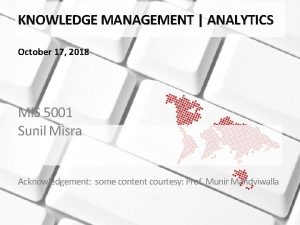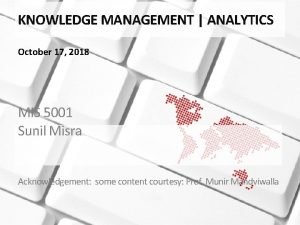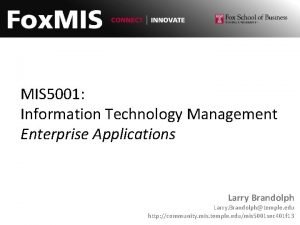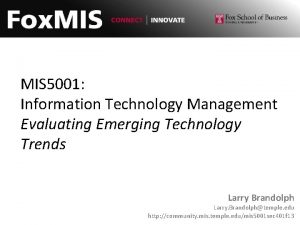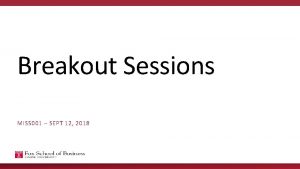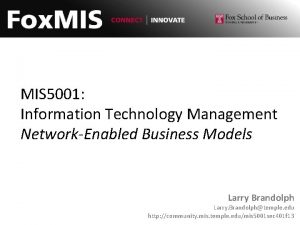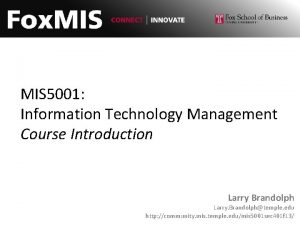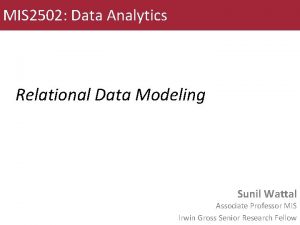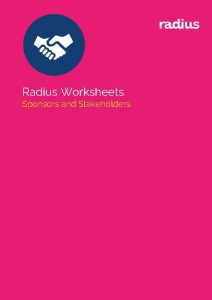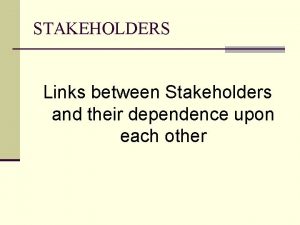Systems Process and Stakeholders MIS 5001 Sunil Misra













































- Slides: 45

Systems, Process, and Stakeholders MIS 5001 Sunil Misra (some material courtesy of Prof. Munir Mandviwalla)

Agenda • Intro & Survey 15 mins • Systems & Process 45 mins • Breakout Activity –part 1 30 mins • Break 15 mins • Stakeholder – Lecture part 2 45 mins • Activity – part 2 30 mins • Final Q&A 15 mins

Guest Speakers – who you gonna call? Tentative List Brian Mandel – Executive Vice President, Deluxe Corp. – Brian is currently scheduled for Sept 11 – Deluxe is a multi-billion dollar 100 year old organization going through its own digital transformation Deepak Batheja – CTO Acoustic Corp – Acoustic is a spinoff from IBM’s Watson group, and it has an industry leading Marketing Automation product which incorporates the best of Watson AI – session date TBD Don Sweeney – Founder, CEO, Ashling Partners – Ashling is a Chicago based boutique consultancy focused on AI based process automation, specifically RPA – Don will be speaking on October 9 th Bart De Maertelaere – Enterprise Architect, NTT, prior COO at Ciber, and Hostway – Bart will discuss the transformation journey, specifically in the Retail and Hospitality and Sports market segments, by the use of new technologies like IOT, etc. – tentatively scheduled for Oct 13 th or 20 th Other invited guests: Jan Uhrich – CSO, Sutherland, EVP Dell Technologies Pam Baxter – Head of Retail, Amazon, ex-CIO Talbot’s, and Starwood

Housekeeping Case study grading rubric

How Much Technology? • Student background • Interest • Goals

SYSTEMS & PROCESSES

Definition of SYSTEM From Miriam-Webster 1. a regularly interacting or interdependent group of items forming a unified whole a number system From the Founder of General Systems Theory Ludwig von Bertalanffy • A system may be defined as a set of elements standing in interrelation among themselves and with environment. • We term a system 'closed' if no material enters or leave it; it is called 'open' if there is import and export of material. • Living systems are not closed systems in true equilibrium but open systems in a steady state.

EXAMPLE Image source: Six Sigma Daily - http: //www. sixsigmadaily. com/methodology/input-output-model

Systems Source: http: //www. lix. polytechnique. fr/~golden/systems_architecture. html

Systems Formal systems example - a university has a purpose - exists for a reason and university 'transforms' students into achieves some change, or 'transformation' graduates performance can be measured ranking, student/faculty ratios, placement there is a mechanism for control management structure has components faculty, administration, departments components are related and interact board meetings, shared courses interacts with a wider system - environment education system, community has a boundary the chair is part of the college, the local mayor is not has its own resources staff, buildings, finance has an expectation of continuity expects and plans to exist into the future

Example – Adaptive System http: //rstb. royalsocietypublishing. org/content/366/1563/389

http: //water. usgs. gov/edu/watercycle. html

SYSTEMS § Purpose – its reason for existence § Boundary – where it begins and ends § Components – the pieces that make up the system § Environment – things outside the system boundary § Inputs – objects and information that enter system § Outputs – objects and information that leave system A system with five subsystems Source: Alter (2006)

SYSTEMS INNOVATION APPROACH Systems Types and means Measures Stakeholders Model Innovative Systems

A BIG SYSTEM: ORGANIZATIONAL ENTERPRISE ARCHITECTURE ERP CRM Devices Network Applications ENTERPRISE ARCHITECTURE LEGEND Data

So What is Enterprise Architecture? MIT CISR defines enterprise architecture as: “the organizing logic for business process and IT capabilities reflecting the integration and standardization requirements of the firm’s operating model. ” Architecture is a strategic, rather than technical, exercise. A firm’s architecture describes a shared vision of how a firm will operate

REFLECTION So what is systems thinking? Why should you care?

PROCESSES Source: Alter (2006) a structured, measurable set of activities designed to produce a specific output. . . It implies a strong emphasis on how work is done within an organization, in contrast to a product focus’s emphasis on what. . . A process is thus a specific ordering of work activities across time and space, with a beginning and an end…Processes are the structure by which an organization does what is necessary to produce value. . . Source: Davenport (1993)

MORE BUSINESS PROCESSES Source: Alter (2006)

Example | Enterprise Digital Transformation » Digital Transformation: connect Customer Experience to Business Operations and Processes » Journey begins with understanding the industry segment, business model and objectives - Which leads to us defining the reference architecture needed Strategy & Business Model Customer Engagement Business Operations and Processes Associate Engagement CRO » » » Customer Journey Mapping Customer Relationship Management Creative / UI/UX Marketing Automation Commerce Analytics Operations CHRO » » » Talent Management Performance Management Workforce Planning HR Analytics Employee Self-Service/ Collaboration Finance CFO COO » » » Forecasting Operational Analytics Enterprise Resource Planning Project Costing Supply Chain Infrastructure and Support » » » Cash Management Budget & Planning Enterprise Resource Planning Financial Analytics Compliance & Reporting

SYSTEM + PROCESSS > INFORMATION SYSTEM What is an Information System? IF SSNO <> 9 Char THEN Error END IF Hardware Software Networking People Data Business Processes A set of interrelated components that collect (or retrieve), process, store, and distribute information to support decision making and control in an organization Source: Laudon, K. , & Laudon, J. Management Information Systems. 8/e

INFORMATION SYSTEMS - LEGACY Transaction Processing Systems Corporate IT Strategic Wyeth Decision Making Managerial Operational Manufacturing Payroll Sales force automation Cirque du Soleil Accounting Sales Personnel Electronic invoicing Finance Human Resources Distribution …

INFORMATION SYSTEMS ERP – Enterprise Resource Planning DM – Digital Marketing SM – Social Media • Enterprise wide systems that automate and integrate key organizational processes such as sales, purchasing, etc. (e. g. , SAP) • An emerging discipline in Marketing which integrates the application of ecommerce, social media, and direct sales (e. g. , Google Ads). • Organizational and consumer applications that focus on processes that have to do with interactivity (e. g. , Facebook) KM – Knowledge Management • A concept and set of systems/processes to retain, transfer, and leverage organizational knowledge (e. g. , Lotus Notes) CRM – Customer Relationship Management • A specific system that automates direct sales, sales force management, and customer relationship processes (e. g. , Salesforce. com) BI – Business Intelligence • AKA Analytics / Big Data • A set of capabilities and processes to get value from organizational data

INFORMATION SYSTEMS – TODAY? BI Strategic CRM Decision Making KM Managerial Operational Manufacturing ERP Accounting Sales TPS 1, TPS 2, …. . Finance Human Resources Distribution …

INFORMATION SYSTEMS – ENTERPRISE APPLICATIONS TRENDS Web 2. 0 Social Media Corporate IT Wyeth Cirque du Soleil Hulu Amex Consumer IT BI CRM ERP DM KM SM UDN Accor Analytics Hulu UDN AMEX Accor DIGITAL BUSINESS MODELS Grow Save Money

DIGITAL BUSINESS MODELS (Ash Maurya) Where do you digitalize? What is a product category? Source: http: //www. ashmaurya. com/2012/02/why-lean-canvas/ Also see https: //strategyzer. com/canvas/business-model-canvas

THE COURSE 1. People are dependent on organizational systems. 2. Organizational systems automate and/or change key business processes. 3. An enterprise architecture (technologies) is a roadmap of key organizational systems 4. Required to to assess the disruptive potential of products and services and the overall industry. Organizations Systems Processes DISRUPTIVE POTENTIAL

About that CMO-CIO divide…

A BIG SYSTEM: ORGANIZATIONAL ENTERPRISE ARCHITECTURE ERP CRM Devices Network Applications ENTERPRISE ARCHITECTURE LEGEND Data

ACTIVITY: ENTERPRISE ARCHITECTURE Process • • Go the automatic group As a group, discuss the following 2 -3 ± minutes discussion per question One person reports out the group’s answer Questions • What is the architecture at Cirque Du Soleil? • Draw it out using the symbols in the previous slides

REFLECTION What did you learn about enterprise architecture? What did you learn about Cirque Du Soleil?

Source: http: //msnbcmedia. msn. com/i/MSNBC/Components/Photo/2009/December/091202/091203 -engel-big-9 a. jpg

http: //www. cc. com/video-clips/flgi 4 b/the-daily-show-with-jon-stewart-afghanistan-

STAKEHOLDER ANALYSIS

What is a Stakeholder • A stakeholder is anybody who can affect or is affected by an organization, strategy or project. They can be internal or external and they can be at senior or junior levels. stakeholdermap. com • A person, group or organization that has interest or concern in an organization. • • Stakeholders can affect or be affected by the organization's actions, objectives and policies. Some examples of key stakeholders are creditors, directors, employees, government (and its agencies), owners (shareholders), suppliers, unions, and the community from which the business draws its resources. Not all stakeholders are equal. A company's customers are entitled to fair trading practices but they are not entitled to the same consideration as the company's employees. Read more: http: //www. businessdictionary. com/definition/stakeholder. html Source: Stakeholder | Definition - What is a stakeholder? https: //www. stakeholdermap. com/stakeholder-definition. html

STAKEHOLDER ANALYSIS

ACTIVITY: CREATE A STAKEHOLDER MAP OF WYETH Process • Go the automatic group • As a group, work on the following • One person reports out the group’s answer Brainstorm stakeholders • Include external • Place Wyeth in context of the larger system • Can stakeholder changes impact the system? Diagram the system • Compare stakeholders lists and arrive at a consensus • Create a stakeholder diagram • What are the implications of weak and strong stakeholders / relationships?

STAKEHOLDER CHECK LIST q q q q q q q q q Accounting Accounts Receivable Actuaries Analytics/Reporting Audit Billing Board members Business Analysts Business Community Catering Charities and not for profit Chief Creative Officer (CCO) Chief Executive (CEO) Chief Finance Officer (CFO) Chief Information Officer (CIO) Chief Operations Officer (COO) Chief Technology Officer (CTO) Civil service Client project team Community and community organizations Company Secretary Competitors Customer Service Customers Department heads Designers Directors Distributers Emergency services Engineering Environmental groups Expenses department Facilities Finance Fraud Government q q q q q q q q q Health and Safety Hospitality Human Resources (HR) Insurance Inventory IT Key Individuals Lease holders Legal Lobby groups Local authority/local governance Local interest group Local people Logistics Maintenance Managers Manufacturers Marketing Media Networking Non - human e. g. Animal Occupational Therapy Operations Other Program and Project Managers Partners Planning Pressure Groups Procurement Product team Professionals e. g. medical Programmers Project team Property owners Public Relations (PR) Publishing Quality Assurance q Recruitment q Regulators (Health & Safety, Central Government) q Research q Resellers q Residents q Revenue recognition q Sales q Security q Senior Management Team q Service providers q Shareholders q Social Media team q Specialists q Staff q Subject Matter Experts q Suppliers q Supply Chain q Telephony/Telecommunications q Trade Unions q Travel agent q Treasurer q Trustees q Unions q Users q Venture capitalists q Venue provider q Veterinary q Vice Presidents (VPs) q Volunteers q Wages (Payroll) q Web development q Working parties q Zealots (any person who is fanatically committed) Source: http: //stakeholdermap. com/stakeholder-list. html

REFLECTION What did we learn about Wyeth? What did we learn about stakeholder analysis and systems?

PROCESS THINKING |SYSTEMS THINKING |DISRUPTION Process Thinking A series of steps and flows Decompose Systems Thinking Collection of processes and technological components Feedback loop Synthesize Business Models Identify market need Apply innovations Evaluate CAN YOU MATCH PROBLEMS TO EACH APPROACH?

Stakeholder Analysis Samples




 Mpi 5001
Mpi 5001 Dr l sunil chandran
Dr l sunil chandran Supply chain management presentation
Supply chain management presentation Sunil mukhi
Sunil mukhi Dr l sunil chandran
Dr l sunil chandran Sunil khatri tamu
Sunil khatri tamu Sunil paudel
Sunil paudel Sunil lobo
Sunil lobo Sunil dhola
Sunil dhola Issuer services
Issuer services Sunil gupta actor
Sunil gupta actor Tactical sunil g
Tactical sunil g Sunil vallamkonda
Sunil vallamkonda Sunil thapar
Sunil thapar Bmcc aatc
Bmcc aatc Misra gries algorithm
Misra gries algorithm Scaruffi pink floyd
Scaruffi pink floyd Mısra i azade
Mısra i azade Bactig
Bactig Sumit misra
Sumit misra Lasert tag
Lasert tag Farinaz edalat
Farinaz edalat Para mi proyecto de vida yo deshecho
Para mi proyecto de vida yo deshecho La hija de mi hermana es mi ___
La hija de mi hermana es mi ___ Mis mai a mis tachwedd
Mis mai a mis tachwedd Mis mai a mis tachwedd
Mis mai a mis tachwedd Mis actos son un reflejo de mis creencias
Mis actos son un reflejo de mis creencias Primary and secondary stakeholders
Primary and secondary stakeholders Internal stakeholders examples
Internal stakeholders examples Software
Software Stakeholders and their interests
Stakeholders and their interests Interactive social system
Interactive social system Specific and pervasive boundaries for behavior
Specific and pervasive boundaries for behavior Stakeholder internal and external
Stakeholder internal and external Stakeholders in water and sanitation
Stakeholders in water and sanitation Adversarial stakeholders
Adversarial stakeholders Understanding your stakeholders
Understanding your stakeholders C level stakeholders
C level stakeholders Real estate stakeholders
Real estate stakeholders Stakeholder classification
Stakeholder classification Internal vs external stakeholders
Internal vs external stakeholders Higher business management
Higher business management Who are stakeholders of a company
Who are stakeholders of a company Scottsdale explantation
Scottsdale explantation Stakeholders scuola
Stakeholders scuola Stakeholders
Stakeholders
